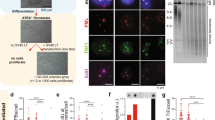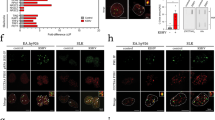Abstract
Normal human cells undergo a limited number of divisions in culture and enter a non-dividing state called replicative senescence1. Senescence is accompanied by several changes, including an increase in inhibitors of cyclin-dependent kinases2,3 and telomere shortening4. The mechanisms by which viral oncogenes reverse these processes are not fully understood, although a general requirement for oncoproteins such as human papillomavirus E6 and E7 has suggested that the p53 and Rb pathways are targeted. Expression of the catalytic component of telomerase, hTERT, alone significantly extends the lifespan of human fibroblasts5. Here we show that telomerase activity is not sufficient for immortalization of human keratinocyte or mammary epithelial cells: we find that neither addition of hTERT nor induction of telomerase activity by E6, both of which are active in maintaining telomere length, results in immortalization. Inactivation of the Rb/p16 pathway by E7 or downregulation of p16 expression, in combination with telomerase activity, however, is able to immortalize epithelial cells efficiently. Elimination of p53 and of the DNA-damage-induced G1 checkpoint is not necessary for immortalization, neither is elimination of p19ARF.
This is a preview of subscription content, access via your institution
Access options
Subscribe to this journal
Receive 51 print issues and online access
$199.00 per year
only $3.90 per issue
Buy this article
- Purchase on Springer Link
- Instant access to full article PDF
Prices may be subject to local taxes which are calculated during checkout



Similar content being viewed by others
References
Hayflick, L. The limited in vitro lifespan of human diploid cell strains. Exp. Cell Res. 37, 614–621 (1965).
Loughran, O.et al. Evidence for the inactivation of multiple replicative lifespan genes in immortal human squamous cell carcinoma keratinocytes. Oncogene 14, 1955–1964 (1997).
Alcorta, D. A.et al. Involvement of the cyclin-dependent kinase inhibitor p16 (INK4a) in replicative senescence of normal human fibroblasts. Proc. Natl Acad. Sci. USA 93, 13742–13747 (1996).
Allsopp, R. C.et al. Telomere length predicts replicative capacity of human fibroblasts. Proc. Natl Acad. Sci. USA 89, 10114–10118 (1992).
Bodnar, A. G.et al. Extension of life-span by introduction of telomerase into normal human cells. Science 279, 349–352 (1998).
Wright, W. E. & Shay, J. W. The two-stage mechanism controlling cellular senescence and immortalization. Exp. Gerontol. 27, 383–389 (1992).
Hawley-Nelson, P., Vousden, K. H., Hubbert, N. L., Lowy, D. R. & Schiller, J. T. HPV 16 E6 and E7 proteins cooperate to immortalize human foreskin keratinocytes. EMBO J. 8, 3905–3910 (1989).
Munger, K., Phelps, W. C., Bubb, V., Howley, P. M. & Schlegel, R. The E6 and E7 genes of the human papillomavirus type 16 together are necessary and sufficient for transformation of primary human keratinocytes. J. Virol. 63, 4417–4421 (1989).
Halbert, C. L., Demers, G. W. & Galloway, D. A. The E7 gene of human papillomavirus type 16 is sufficient for immortalization of human epithelial cells. J. Virol. 65, 474–478 (1991).
Foster, S. A. & Galloway, D. A. Human papillomavirus type 16 E7 alleviates a proliferation block in early passage human mammary epithelial cells. Oncogene 12, 1773–1779 (1996).
Foster, S. A., Wong, D. J., Barrett, M. T. & Galloway, D. A. Inactivation of p16 in human mammary epithelial cells by CpG island methylation. Mol. Cell. Biol. 18, 1793–1801 (1998).
Shay, J. W., Wright, W. E., Brasiskyte, D. & van der Haegen, B. A. E6 of human papillomavirus type 16 can overcome the M1 stage of immortalization in human mammary epithelial cells but not in human fibroblasts. Oncogene 8, 1407–1413 (1993).
Band, V., Zajchowski, D., Kulesa, V. & Sager, R. Human papilloma virus DNAs immortalize normal human mammary epithelial cells and reduce their growth factor requirements. Proc. Natl Acad. Sci. USA 87, 463–467 (1990).
Shay, J. W., van der Haegen, B. A., Ying, Y. & Wright, W. E. The frequency of immortalization of human fibroblasts and mammary epithelial cells transfected with SV40 large T-antigen. Exp. Cell Res. 209, 45–52 (1993).
Nakamura, T. M.et al. Telomerase catalytic subunit homologs from fission yeast and human. Science 277, 955–959 (1997).
Klingelhutz, A. J., Foster, S. A. & McDougall, J. K. Telomerase activation by the E6 gene product of human papillomavirus type 16. Nature 380, 79–82 (1996).
Wang, J., Xie, L. Y., Allan, S., Beach, D. & Hannon, G. J. Myc activates telomerase. Genes Dev. 12, 1769–1774 (1998).
Klingelhutz, A. J., Barber, S. A., Smith, P. P., Dyer, K. & McDougall, J. K. Restoration of telomeres in human papillomavirus-immortalized human anogenital epithelial cells. Mol. Cell. Biol. 14, 961–969 (1994).
Stoppler, H., Hartmann, D. P., Sherman, L. & Schlegel, R. The human papillomavirus type 16 E6 and E7 oncoproteins dissociate cellular telomerase activity from the maintenance of telomere length. J. Biol. Chem. 272, 13332–13337 (1997).
Khleif, S. N.et al. Inhibition of cyclin D-CDK4/CDK6 activity is associated with an E2F mediated induction of cyclin kinase inhibitor activity. Proc. Natl Acad. Sci. USA 93, 4350–4354 (1996).
Demers, G. W., Foster, S. A., Halbert, C. L. & Galloway, D. A. Growth arrest by induction of p53 in DNA damaged keratinocytes is bypassed by human papillomavirus 16 E7. Proc. Natl Acad. Sci. USA 91, 4382–4386 (1994).
Scheffner, M., Werness, B. A., Huibregtse, J. M., Levine, A. J. & Howley, P. M. The E6 oncoprotein encoded by human papillomavirus types 16 and 18 promotes the degradation of p53. Cell 63, 1129–1136 (1990).
Kiyono, T.et al. Binding of high risk human papillomavirus E6 oncoproteins to the human homologue of the Drosophila discs large tumor suppressor protein. Proc. Natl Acad. Sci. USA 94, 11612–11616 (1997).
Dalal, S., Gao, Q., Androphy, E. J. & Band, V. Mutational analysis of human papillomavirus type 16 E6 demonstrates that p53 degradation is necessary for immortalization of mammary epithelial cells. J. Virol. 70, 683–688 (1996).
Kamijo, T.et al. Tumor suppression at the mouse INK4A locus mediated by the alternative reading frame product p19ARF. Cell 91, 649–659 (1997).
Gross-Mesilaty, S.et al. Basal and human papillomavirus E6 oncoprotein-induced degradation of Myc proteins by the ubiquitin pathway. Proc. Natl Acad. Sci. USA 95, 8058–8063 (1998).
Huibregtse, J. M., Scheffner, M. & Howley, P. M. Cloning and expression of the cDNA for E6-AP, a protein that mediates the interaction of the human papillomavirus E6 oncoprotein with p53. Mol. Cell. Biol. 13, 775–784 (1993).
Kim, N. W.et al. Specific association of human telomerase activity with immortal cells and cancer. Science 266, 2011–2015 (1994).
Krupp, G.et al. Molecular basis of artifacts in the detection of telomerase activity and a modified primer for a more robust ‘TRAP’ assay. Nucleic Acids Res. 25, 919–921 (1997).
Wright, W. E., Shay, J. W. & Piatyszek, M. A. Modifications of a telomeric repeat amplification protocol (TRAP) result in increased reliability, linearity and sensitivity. Nucleic Acids Res. 23, 3794–3795 (1995).
Acknowledgements
We thank the Geron Corporation for the hTERT cDNA, E. Espling for maintaining stocks of retroviruses, the Image Analysis Laboratory for help with preparing figures, and members of the McDougall and Galloway laboratories for discussion. This work was supported by grants from the NIH to J.K.M. and D.A.G.
Author information
Authors and Affiliations
Corresponding author
Rights and permissions
About this article
Cite this article
Kiyono, T., Foster, S., Koop, J. et al. Both Rb/p16INK4a inactivation and telomerase activity are required to immortalize human epithelial cells. Nature 396, 84–88 (1998). https://doi.org/10.1038/23962
Received:
Accepted:
Issue Date:
DOI: https://doi.org/10.1038/23962
This article is cited by
-
Loss of fragile WWOX gene leads to senescence escape and genome instability
Cellular and Molecular Life Sciences (2023)
-
Immortalization of primary cells derived from the endangered Ryukyu long-furred rat
In Vitro Cellular & Developmental Biology - Animal (2023)
-
Puromycin-based purification of cells with high expression of the cytochrome P450 CYP3A4 gene from a patient with drug-induced liver injury (DILI)
Stem Cell Research & Therapy (2022)
-
Post-GWAS functional analysis identifies CUX1 as a regulator of p16INK4a and cellular senescence
Nature Aging (2022)
-
Restoration of keratinocytic phenotypes in autonomous trisomy-rescued cells
Stem Cell Research & Therapy (2021)
Comments
By submitting a comment you agree to abide by our Terms and Community Guidelines. If you find something abusive or that does not comply with our terms or guidelines please flag it as inappropriate.



